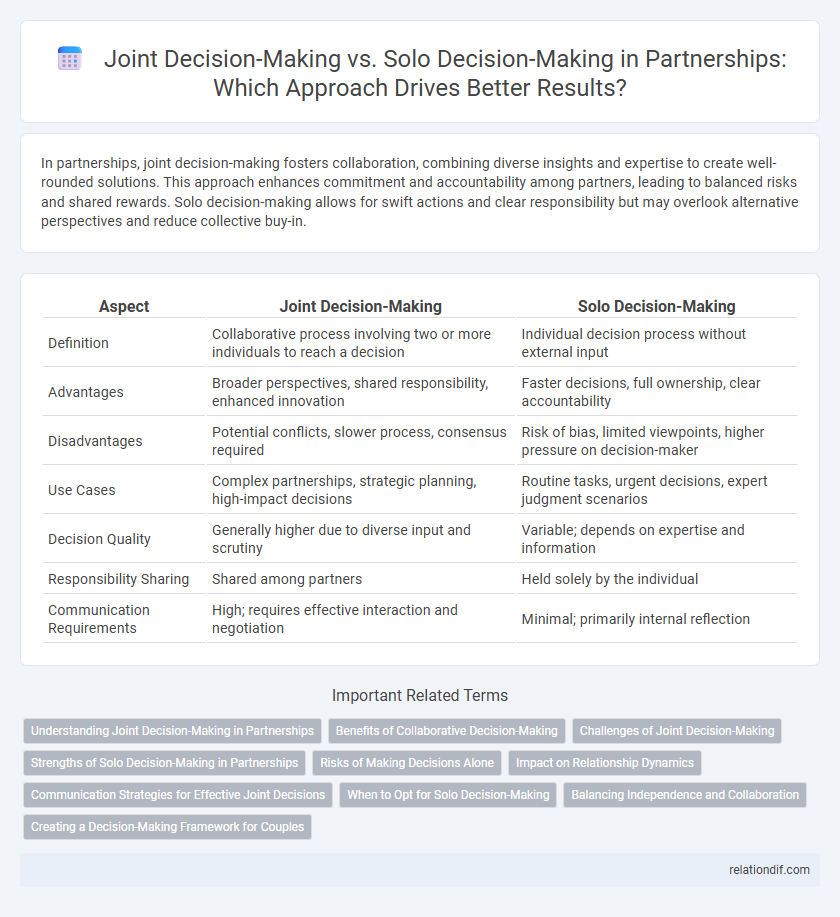In partnerships, joint decision-making fosters collaboration, combining diverse insights and expertise to create well-rounded solutions. This approach enhances commitment and accountability among partners, leading to balanced risks and shared rewards. Solo decision-making allows for swift actions and clear responsibility but may overlook alternative perspectives and reduce collective buy-in.
Table of Comparison
| Aspect | Joint Decision-Making | Solo Decision-Making |
|---|---|---|
| Definition | Collaborative process involving two or more individuals to reach a decision | Individual decision process without external input |
| Advantages | Broader perspectives, shared responsibility, enhanced innovation | Faster decisions, full ownership, clear accountability |
| Disadvantages | Potential conflicts, slower process, consensus required | Risk of bias, limited viewpoints, higher pressure on decision-maker |
| Use Cases | Complex partnerships, strategic planning, high-impact decisions | Routine tasks, urgent decisions, expert judgment scenarios |
| Decision Quality | Generally higher due to diverse input and scrutiny | Variable; depends on expertise and information |
| Responsibility Sharing | Shared among partners | Held solely by the individual |
| Communication Requirements | High; requires effective interaction and negotiation | Minimal; primarily internal reflection |
Understanding Joint Decision-Making in Partnerships
Joint decision-making in partnerships involves collaborative evaluation of options, leveraging diverse perspectives and expertise to achieve mutually beneficial outcomes. This approach enhances communication, fosters trust, and aligns partner goals, which improves long-term strategic planning and conflict resolution effectiveness. Emphasizing shared accountability and transparent dialogue, joint decision-making minimizes risks associated with unilateral choices and contributes to sustained business growth.
Benefits of Collaborative Decision-Making
Collaborative decision-making in partnerships accelerates problem-solving by leveraging diverse expertise and perspectives, leading to more innovative and effective solutions. Shared accountability enhances commitment and reduces risks associated with unilateral errors, fostering stronger trust and alignment among partners. This approach also improves resource utilization and facilitates learning, driving sustained organizational growth and resilience.
Challenges of Joint Decision-Making
Joint decision-making often faces challenges such as conflicting interests, communication barriers, and slower consensus-building processes, which can hinder timely outcomes. Diverse perspectives may lead to disagreements, requiring extensive negotiation and compromise. Managing varying priorities and expectations demands strong facilitation skills and robust conflict resolution strategies.
Strengths of Solo Decision-Making in Partnerships
Solo decision-making in partnerships offers agility and speed, allowing quick responses to urgent issues without the delays of consensus-building. It empowers individual accountability, ensuring decisions are clearly owned and implemented efficiently. This approach is particularly effective in situations requiring specialized expertise or when immediate action is critical.
Risks of Making Decisions Alone
Solo decision-making carries significant risks including limited perspectives, cognitive biases, and increased likelihood of errors due to lack of diverse input. Without the collaborative checks and balances found in joint decision-making, individuals may overlook critical information or fail to anticipate consequences. This isolation in decision processes can lead to ineffective solutions and greater vulnerability to unforeseen challenges.
Impact on Relationship Dynamics
Joint decision-making fosters trust and collaboration by encouraging open communication and mutual respect, which strengthens the partnership's foundation. Solo decision-making can create power imbalances and reduce transparency, potentially leading to misunderstandings and weakened relational bonds. The dynamics of partnerships improve significantly when decisions are shared, promoting accountability and long-term commitment.
Communication Strategies for Effective Joint Decisions
Effective joint decision-making in partnerships relies heavily on transparent communication strategies, such as active listening and clarifying questions, to ensure all perspectives are considered. Utilizing structured dialogue techniques like round-robin sharing and consensus-building tools enhances mutual understanding and alignment. Establishing regular check-ins and documented agreements supports accountability and continuous collaboration throughout the decision-making process.
When to Opt for Solo Decision-Making
Solo decision-making is ideal when quick, decisive action is critical, such as during emergencies or when confidential matters are involved. It minimizes delays by eliminating the need for consensus among partners, enabling swift execution. Situations with clearly defined responsibilities or specialized expertise also benefit from individual authority to optimize efficiency and accountability.
Balancing Independence and Collaboration
Joint decision-making fosters diverse perspectives and shared accountability, enhancing strategic alignment and innovation within partnerships. Solo decision-making allows for swift, independent actions but risks overlooking collaborative insights that drive comprehensive solutions. Balancing independence with collaboration requires clear communication channels and mutual respect to optimize decision quality and partnership dynamics.
Creating a Decision-Making Framework for Couples
Creating a decision-making framework for couples involves establishing clear guidelines that balance joint input and individual autonomy to ensure fair and efficient outcomes. Emphasizing open communication, shared values, and defined roles helps prevent conflicts and fosters mutual respect in the partnership. Utilizing tools like regular check-ins or decision matrices enhances transparency and strengthens the collaborative process.
Joint Decision-Making vs Solo Decision-Making Infographic

 relationdif.com
relationdif.com